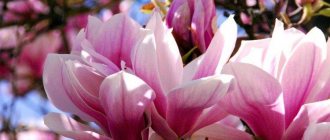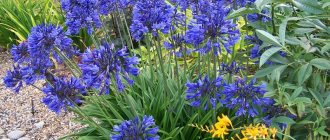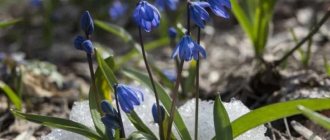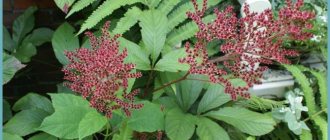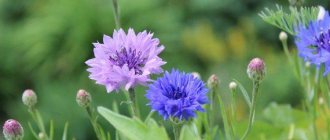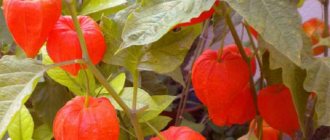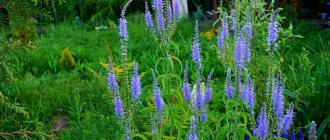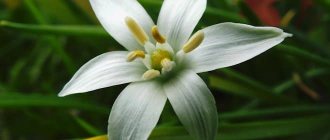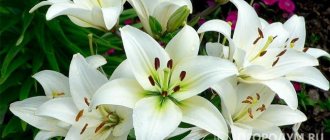The crop can be evergreen or deciduous. In total there are 120 varieties of the crop. Many magnolia varieties bred by modern breeders are excellent for cultivation in the middle zone. Evergreen magnolias are intended for southern regions with a humid, warm climate. Deciduous trees are frost-resistant magnolias that can withstand low ambient temperatures for a long time.
Types of magnolias that are grown in cold regions: large-leaved magnolia, Kobus magnolia, star magnolia, Loebner magnolia, tripetal magnolia, virginian magnolia.
Conditionally winter-hardy species that prefer warm weather, without severe frosts: magnolia Soulange, lily-flowered, magnolia Ashe.
Exotic crops of southern latitudes: large-flowered magnolia, evergreen “Gallisoninsis grandiflora”, “Gallisoninsis Nana”.
Virginskaya
Sweet bay
Magnolia virginiana is a deciduous or semi-evergreen tall bush, reaching a height of 20 m. The trunk of representatives of the species is straight, the branches are bare, the buds are covered with tiny fibers. Magnolia virginiana has oval, semi-evergreen leaves, with a pointed apex and a wide base, up to 12 cm long. The leaf blade on top is dark olive, smooth, polished. The leaves below are smoky-turquoise, delicate, velvety, pubescent along the midrib. The petioles are small, no more than 2 cm long, smooth, not pubescent.
The flowering period of representatives of the variety begins in April; blooms until July, not abundantly, but steadily. Flowers up to 7 cm in diameter, milky white, fragrant, about 9 - 12 petals.
Many fans of the culture believe that the flowers of Magnolia Virginiana have an inimitable, intoxicating aroma.
The fruits of the plant are dark purple in color, up to 5 cm long, shaped like an ellipse or a cone. The seeds are covered with a dense purple shell.
Pest and disease control
The most dangerous enemy of magnolia is moles, rats, voles and shrews, which create their own tunnels and destroy the root system. Here you will have to control the situation, use mechanical traps or plant trees in wire baskets.
In hot weather, spider mites often appear, and thrips, aphids and mealybugs are also found. Insecticides help with all this, and even better - planned preventive treatment.
The most common magnolia diseases are powdery mildew, scab and gray mold. These are all fungal diseases that can be treated well with fungicides. If symptoms of bacterial spot appear, use copper sulfate.
Yellow spots on leaves with green veins are the first symptom of chlorosis. This is not exactly a disease, but a sure sign of an excess of lime in the soil. Before the root system is damaged, add coniferous soil or acidic peat to the soil.
Photo: 5stihiynn.ru
Ranunculus flowers (50 photos): types, planting and care
Susan
Magnolia Susan
Magnolia Susan is a popular hybrid of Magnolia Liliaceae and Star Magnolia. It is a dense shrub up to 4 m high, first resembling a cone, and the older it gets, acquiring a rounded shape. The leaves are large, dark olive. The flowers are voluminous, up to 1 cm in diameter, dark scarlet at the base, lighter at the ends. Representatives of the variety do not smell strongly, but pleasantly. The flowering period is long and lush.
The plant prefers sunny places, without strong winds, and slightly acidic, fertile soils. In winter, specimens of the variety need shelter only in the first couple of years after planting.
Magnolia Susan is a variety that seems specially created for small, cozy gardens.
Malicious factors
Among the harmful ones are rodents and moles. Some gnaw the root system, others dig them up. Lubricate the damaged areas with a 1% foundation solution.
Spider mites are dangerous in hot, dry weather. It absorbs the juice of the leaves, causing them to die completely.
large-leaved
Magnolia macrofolia
Large-leaved magnolia is a deciduous tree up to 23 m high, with a dense, elongated, rounded crown, shaped like a pyramid. The trunk is straight, up to 50 cm in diameter; the bark is thin, smooth, smoky. In adult representatives, the bark acquires the ability to crack into tiny flat plates. Young shoots are covered with thin fluff. Representatives of the variety have large, thin leaves, up to 100 cm long, with wavy edges and a blunt apex, heart-shaped at the base. The leaf blade is glossy and malachite on top; the leaves are grayish underneath and covered with delicate short hairs.
Large-leaved magnolia has flowers of unusual colors in the upper tier of the crown: there are three blueberry spots on the inner petals. The flowers are large, up to 30 cm in diameter, fragrant: at first snow-white, and closer to the end of flowering, acquiring an ivory hue. The plant's buds appear after the leaves bloom, in April - May. The fruit, which ripens closer to August, is an oval polyfolia of purple color, up to 8 cm long.
Lebner
Magnolia Loebner
Magnolia Loebner "Leonard" is a deciduous tree up to 9 m high, a hardy hybrid of Kobus and Star magnolias, with a rounded crown and a wonderful aroma. The leaves are oval-shaped, their arrangement is alternate. The time for flowering of the crop begins in mid-spring. The voluminous buds of the plant, up to 14 cm in diameter, are shaped like stars, white or pearlescent. The outer petals of the flower are distinguished by blue-scarlet or pink-purple stripes, the inside of the petals is white.
Representatives of the species prefer acidic, fertile, moist and drained soils. Choose a place for the plant in open sun or light shade. A favorable time for planting deciduous magnolia is early spring.
Betty
Magnolia hybrid Betty
Magnolia hybrid Betty is a deciduous shrub up to 4 m high, with a rounded crown. The leaves are oblong, up to 10 cm long. The flowering stage begins in mid-spring, before the leaves bloom. The flowers are large, up to 20 cm in diameter, scarlet on the outside and white-pearl on the inside, the petals are narrow, slightly curled. The culture blooms profusely until early July.
For rapid formation and growth, the crop must be planted in an open sunny place, protected from the winds.
Magnolia acuminate (M. acuminata)
Several interesting magnolia species are native to the North American continent. In the mountainous regions of the central United States, you can see the pointed magnolia with a tall crown, reddish bark and elliptical leaves up to 20 cm long.
Unlike Asian species, which bloom before foliage emerges, most American plants bloom against a background of greenery. Therefore, the buds and yellow-green flowers that resemble bells do not look so impressive. However, this does not prevent botanists from showing serious interest in the hardy species, which crosses well with other magnolias.
Magnolia with red fruits transmits excellent winter hardiness to its descendants from interspecific crossing. And its seedlings serve as rootstocks for more decorative, but less flexible relatives. An example of successful hybridization is the Brooklyn magnolia, which is not afraid of frost and decorates the garden with purple flowers, the shape and tone reminiscent of the mother plant - magnolia lily. Russia has successful experience in growing M. acuminata f. cordata with small flowers of a rich yellow hue.
Due to the similarity of magnolia ovaries with cucumbers, in the USA the plant is often called a cucumber tree. However, the official name Magnolia borage refers only to M. acuminata.
Three-petalled
Umbrella tree
Magnolia tripetallus is a deciduous tree up to 12 m high, with a crown that looks like an impressive umbrella. The bark of the trees is light-smoky and smooth. The shoots are dense, crimson-lead or brown-olive, with pronounced leaf scars, the buds are brown-green. The leaves are large, oblong, with a pointed apex. The leaf blade is light olive on top, smooth; the leaves below are greenish-gray, with convex veins, covered with short hairs.
Magnolia tripetallus has large flowers up to 25 cm in diameter, creamy in color, shaped like oblong cups. Thanks to this structure of flowers, the beetles that pollinate them freely penetrate the buds. The fruits of the crop are multi-leafed, oblong, wine-colored, containing resinous, flat seeds. The flowering period begins after the leaves bloom.
Willow
Magnolia looseleaf
Magnolia loosestrife is an elegant deciduous tree or large shrub up to 10 m high, with a conical crown with several tiers. The bark of the magnolia loosestrife trunk is smooth and smoky in color. Young shoots of representatives of the species are lead-olive, tender and silky. Adult shoots are smoky-brown and greenish. The leaves are long and narrow, pointed, oval in shape. The leaf blade is light olive on top, bluish below, covered with tiny hairs along the veins.
Magnolia flowers are creamy in color, with a strong anise scent, and are shaped like bells. The flowering stage begins before the leaves bloom, in the first half or mid-April. Repeated flowering is possible in August or September. The fruit is a composite leaflet, shaped like a slightly curved cylinder.
Interestingly, during the growth process, on the illuminated side the fruits acquire a pinkish tint. If you grind the vegetative parts of the plant, the air will be filled with an aniseed fragrance.
Methods of preparation and use
Traditional medicine uses all parts of the medicinal magnolia, its leaves, flowers, fruits and wood. Typically, raw materials are infused on an alcohol or water base, and valuable substances are transferred into liquid.
Magnolia tincture
A strong magnolia tincture is used for colds, sluggish digestion, infections and joint ailments. It is prepared according to the following algorithm:
- Grind magnolia seeds in a volume of 10 g.
- Pour the raw material with a glass of 70% medical alcohol in a glass container.
- Shake thoroughly and put away in a dark place for 10 days.
After the expiration date, filter the tincture and take 30 drops before meals three times a day. In total, treatment can be continued for up to a month, then be sure to take a break.
When used externally, magnolia seed tincture fights infections and bacteria well.
Infusion
An aqueous infusion of the plant is in demand mainly in hair care. They do it like this:
- Grind two large spoons of dry leaves.
- Pour 1 liter of hot water into the raw plant material.
- Leave for a day under a closed lid.
- Strain through cheesecloth.
An infusion of the plant is used as a rinse for dandruff, itching and severe early baldness. You need to use it once a week for several months.
An aqueous infusion of magnolia can treat skin irritations.
Liliaceae
Magnolia Liliaceae
Magnolia Liliaceae Nigra or orchid tree is a shrub or tree up to 6 m high, with rather branched, voluminous foliage. The bark of the tree trunk is smooth, light-smoky in color. Young shoots of the crop are initially olive-colored; adult specimens have purplish-brown branches. The leaves of the plant are large, oval in shape, tapered at the base, dark olive above, light green below.
Flower buds are covered with lemon-silver hairs. The flowers are narrow, cup-shaped, scarlet on the outside, milky on the inside, with a delicate, subtle aroma. The flowering time begins in late spring, along with the appearance of leaves. Repeated flowering is possible between July and September.
The fruit is a multifoliate, cylindrical, purple in color, with black seeds, ripens in late October - November.
Why magnolia is dangerous and contraindications for use
The use of magnolia fruits, plant leaves and bark is not permitted for everyone. It is necessary to avoid using natural infusions and decoctions:
- for individual allergies;
- during pregnancy in the first trimester;
- during breastfeeding;
- in children up to three years of age.
Magnolia belongs to the category of slightly toxic plants and poses a danger in case of overdose. If you exceed safe amounts of medication or inhale the aroma for too long, side effects may occur - nausea, dizziness, fatigue, headache. If you feel worse, you should immediately stop using magnolia and consult a doctor.
Brooklyn
Magnolia Brooklyn
Magnolia Brooklyn is a fast-growing deciduous tree up to 20 feet tall. The crown is small, pyramidal. The light chestnut or smoky bark of the plant is covered with grooves. The branches of specimens of the species are purple-brown-gray. The leaves are dark olive in color, elongated, satiny, with entire, slightly wavy edges.
Representatives of the species have flowers of a wide variety of shades, from lemon and yellow-green to lilac-blue. The first buds appear in late spring - early summer. The fruits are pink-scarlet leaflets, shaped like a pine cone. Fruits in September. For planting, choose a sunny place, sheltered from piercing winds, with acidic or neutral soil.
Magnolia Elizabeth
Botanists' favorite variety of Brooklyn magnolia: Magnolia Elizabeth. Yellow magnolia or Magnolia Elizabeth is a medium-sized evergreen or deciduous tree, depending on the local climate, about 8 meters high, with pyramid-shaped foliage. The leaves are oval, leathery, glossy, olive in color. The flowers of the plant are straw-colored, goblet-shaped, fragrant. Magnolia flower buds bloom in late spring and early summer.
Representatives of the variety grow actively in areas illuminated by the sun or in partial shade. Even in a practically mild climate, the weather is unpredictable, and cold winters cannot be ruled out. Therefore, it is necessary to prepare in advance for the frosty season by collecting covering material in a convenient corner of the garden. For protection, spruce branches, reed or straw mats, and mature compost can be used.
Genie
Camellia Genie
Genie is a hybrid of the magnolia Soulange and Liliaceae Nigra. Deciduous compact shrub up to 3 meters high, with a refined columnar crown shape. Elastic young shoots of olive color acquire a chestnut hue over time. The leaves are tobacco green, oval.
Voluminous, goblet-shaped flowers of a dark wine color, shaped like tulips or lotus flowers. The abundant flowering of representatives of the hybrid lasts throughout the spring. Blooms again in late summer.
Kobus
Magnolia Kobus
Magnolia Kobus is a deciduous tree or bush up to 25 meters high. The fleshy roots of the plant are located in different ways: close to the surface of the soil and deep in the soil. Young trees have a narrow, pyramidal crown, adult representatives have delicate leafless shoots and a rounded crown. The bark of the plant trunk is dark gray. The leaves are oval, with a wedge-shaped apex, dark malachite above, light below. The flowers are creamy white, with a sweet aroma. The culture pleases with the appearance of buds in early spring, right up to the blossoming of leaves.
The tree grows quite quickly and prefers fresh, porous and moist soil. The tropical beauty is perfectly suited to slightly acidified and humus-rich soil.
Seedlings of the sultry beauty begin to flower after 7 years, but sometimes flora lovers are forced to wait 30 years for the first buds to appear. Vegetatively propagated representatives of the crop delight with wonderful flowers 10 years after planting. If growing conditions are unfavorable, the crop may not bloom at all.
Kobus is the most resistant of all East Asian species; the crop can withstand short-term frosts down to -34 degrees. As for tree pruning, it is carried out for sanitary purposes, as necessary.
This type of magnolia has the popular northern form, with a cone-shaped crown and larger pearlescent flowers than the main species. Northern magnolia is more frost-hardy than typical magnolia.
Types and varieties of magnolia with photos and names
The largest collections of magnolias are in the UK, namely in the Royal Botanic Garden and in the Arnold Arboretum introduction center. There is also quite a beautiful collection in Kyiv. The types that are most popular among gardeners will be described below.
Magnolia sieboldii
The height of such a deciduous tree is about 10 meters. However, most often this species is represented by a shrub. Its leaf blades are broadly elliptical in shape and reach 15 centimeters in length. On a thin, pubescent peduncle there is a slightly drooping, fragrant, white, cup-shaped flower. Flowers in diameter can reach 7–10 centimeters. This species is one of the most winter-resistant; it can withstand short frosts down to minus 36 degrees. Cultivated since 1865
Magnolia obovate (Magnolia obovata), or white-flowered magnolia
This species comes from Japan and from the island of Kunashir, which is located in the Kuril Islands. The height of this deciduous tree is about 15 meters. The color of the smooth bark is gray. Leaf plates of 8–10 pieces are collected at the ends of the stems. The diameter of the spectacular white-cream flowers is about 16 centimeters, they stand out because they have a spicy smell. The length of the rich red fruit is about 20 centimeters. This plant looks spectacular all year round, it is shade-tolerant and frost-resistant, but at the same time it is demanding on the level of air and soil humidity. Cultivated since 1865
Magnolia officinalis (Magnolia officinalis)
The homeland of this species is China. This plant is considered an analogue of magnolia officinalis, but its leaf blades are larger. The large, fragrant flowers are similar in appearance to water lilies, but they have narrower petals that taper towards the top. In its homeland, this species is used as a medicinal plant, but in mid-latitudes it can be found extremely rarely.
Magnolia acuminata, or borage magnolia
This plant is native to central North America. Under natural conditions, it prefers to grow in deciduous forests at the foot of the mountains, as well as along the rocky banks of mountain rivers. This deciduous tree can reach a height of about 30 meters. The young plant has a pyramidal crown shape, but it gradually becomes rounded. Elliptical or oval leaf plates reach 24 centimeters in length. Their front side is painted dark green, and the back side is greenish-gray; there is short pubescence on its surface. The diameter of the bell-shaped flowers is about 8 centimeters, they are colored greenish-yellow, in some cases there is a bluish coating on the surface. This species is the most frost-resistant of all. This species has a shape with round or heart-shaped leaf blades at the base. The canary-colored flowers are not as large as those of the main species. In the USA, specialists obtained hybrid magnolias by crossing magnolia lily and magnolia acuminata; they are united under the name Brooklyn magnolia.
Magnolia stellata
This type is one of the most beautiful and graceful. He is originally from Japan. The plant is a shrub or a not very large tree, the height of which can reach 250 centimeters. The branches are bare and brownish-gray in color. The shape of the leaf plates is narrowly elliptical, their length is about 12 centimeters. The diameter of the unusual flowers is approximately 10 centimeters, they have a large number of snow-white petals of an elongated ribbon-like shape, they extend in all directions, which is similar to the rays of a star. There are 2 decorative forms: Kei and pink. Several varieties and hybrids are also popular among gardeners. For example, magnolia Susan is a variety that has flowers whose outer part is painted a dark red-purple color, and the inner part is a paler shade. This variety is part of a series of hybrids with female names: Betty, Pinky, Jane, Judy, Anna, Randy and Ricky. This series was born in the fifties of the last century.
Magnolia liliflora
This species is very popular among gardeners. Presumably, the birthplace of this plant is eastern China; it appeared in Europe in 1790. The flowering is lush, the diameter of the flowers with a subtle scent is about 11 centimeters, and their shape is very similar to a lily. Their inner surface is white, and their outer surface is purple. The decorative form of this species of Nigra (Nigre) deserves special attention: the outer surface of its flowers is red-ruby, and the inner surface is lilac-white; flowering begins in the last days of April or the first days of May.
Magnolia kobus
This plant is native to South Korea, as well as central and northern Japan. It came to New York in 1862, and from there it was brought to Europe in 1879. Under natural conditions, the height of the tree can be 25 meters, but in cultivation it does not exceed 10 meters. Wide, obovate-shaped leaf blades have a pointed apex. Their front surface is rich green, and their back surface is painted in a paler shade. The diameter of the fragrant white flowers is about 10 centimeters. The first flowering of such a magnolia can only be seen when it is 9–12 years old. This type is frost-, dust- and gas-resistant. The northern form is a plant with larger flowers and is even more frost-resistant.
Magnolia grandiflora
Native to southeastern North America. The slender trunk has a cylindrical shape. The crown has a very impressive shape. The color of the large glossy leaf blades is dark green. The diameter of the white flowers is about 25 centimeters, they have a sharp spicy smell. The fruits are also highly decorative, they are very bright and have a cone-like shape. While the plant is young, it is characterized by slow growth, so the annual growth is only 0.6 m. It has low winter hardiness and can withstand frosts of at least minus 15 degrees. This species grows well in urban conditions, it is durable and highly resistant to pests and diseases. Basic decorative forms:
- Narrow-leaved . The leaf blades are narrower compared to the main type.
- Lanceolate. The foliage shape is elongated.
- Famous . The leaf blades are very wide, and the diameter of the flowers is approximately 0.35 m.
- Round-leaved . The leaf blades are painted a very dark green shade. The diameter of the flowers is approximately 15 centimeters.
- Early . Flowering begins earlier compared to the main species.
- Exonic . This tall tree has a narrow pyramidal crown shape. The leaf blades are oblong and have pubescence on the lower surface.
- Praverti . The shape of the crown is strictly pyramidal.
- Gartvis . The crown shape is pyramidal, the foliage is wavy.
- Draconian . The crown is very low. Arched hanging branches touch the ground and quickly take root.
- Gallisonskaya . It has greater frost resistance compared to the main type.
Magnolia Sulangeana (Magnolia x soulangeana)
This hybrid was born in 1820 thanks to the Frenchman E. Soulange, who was a scientist. At the moment, more than 50 forms of this hybrid have been registered, and all of them are very popular in almost every country. The height of such a deciduous shrub or tree does not exceed 5 meters. The length of the obovate leaf plates is about 15 centimeters. The diameter of the goblet-shaped flowers can vary from 15 to 25 centimeters, they are fragrant, and in some cases they have no smell at all. They can be colored in various shades from purple to light pink. A plant with white flowers is extremely rare to see. This magnolia is resistant to adverse environmental influences and is not demanding on the composition of the soil. The most popular garden forms:
- Lenne . The inner surface of the fragrant flowers is white, and the outer surface is purple-pink.
- Alexandrina . The height of magnolia is about 8 meters, it is resistant to drought. The outer surface of the flowers is dark purple, and the inner surface is white.
- Rubra (red) . The outer surface of the flowers is red-pinkish.
- German _ The crown shape is pyramidal.
This hybrid also has a large number of varieties.
In addition to the species described above, gardeners cultivate willow magnolia, large-leaved magnolia, Lebner magnolia, naked magnolia, three-petalled magnolia, or umbrella magnolia, etc.
Magnolias in central Russia. Types, planting, care, wintering.
Large-flowered
Magnolia grandiflora
Magnolia grandiflora is an evergreen tree up to 30 meters high. Magnolia grandiflora has a wide crown, shaped like a pyramid. The bark is smoky or chestnut. The flowers of the magnolia tree are single, growing on the tops of the shoots, voluminous, white-creamy, with an intense intoxicating odor. The flowering time lasts from May to September. The tropical crop bears fruit in October-November. The charming enchantress remains viable even with a short drop in temperature to -15 degrees.
Magnolia nude
Magnolia nude
Magnolia nuda is a deciduous tree or tall shrub. It blooms with large milky cream flowers that have a pleasant rich aroma. The flowering stage of the plant begins before the leaves bloom. When growing representatives of the species from seeds, the first buds will appear no earlier than after 4 years, and in some cases, magnolia will delight you with flowers only after 10 years. Breeders have developed several hybrid forms of representatives of the culture, differing in appearance and flowering periods.
Planting and propagation
At home, magnolia is almost never propagated by seeds, because it is time-consuming and difficult. Just their preparation, soaking and stratification takes about a month. And it takes several years to grow seedlings.
It is more convenient to use layering. To do this, choose a healthy but low branch in the spring, bury it in a groove in the ground, pin it, and moisten it regularly. It is worth replanting the cuttings no earlier than after 2 years.
Using the same principle, you can propagate magnolia by cuttings. Choose healthy semi-lignified shoots, cut off the lower leaves and treat with a growth stimulator. The cuttings are planted in boxes with sand and peat for rooting.
You need moderate humidity and a stable temperature of 22 degrees. A greenhouse is best suited for this, and small cuttings can be rooted under a jar. They take root in about 2-4 months, and after a year they can be transplanted into the garden. Magnolias can be planted in holes or trenches.
Photo: autogear.ru
Sulanzha
Magnolia Sulanja
Magnolia Soulange is a hybrid of Magnolia glabra and Magnolia Liliaceae. Magnolia Sulanja is a deciduous tree or shrub up to 8 meters high. The leaves are large, light olive. The dazzling culture delights its fans with lush blooms in mid-spring. The fruits of the plant appear closer to autumn.
Magnolia of this type can withstand frosts down to -22 degrees. If you provide sunny places for the development of the culture, protected from cold winds, it will abundantly and quite early reward its fans with luxurious buds. The plant is able to withstand the influence of unfavorable climatic conditions and actively develops on various soils, preferring fertile, porous soil.
Representatives of the species constantly need sunlight, so they feel bad even in partial shade.
As for late frosts, they can harm the flowers, but the plant can quickly recover.
Widely known exotic forms and varieties:
- f. Lennei - fragrant flowers, scarlet, with a pearlescent tint on the outside, milky on the inside;
- f. rubra – bright, crimson-pink flowers;
- f. Alexandrina – pearlescent flowers, dark scarlet on the outside;
- f. Niemetzii is a plant with a cone-shaped crown and a variety of flower colors, mainly white and strawberry shades.
Siebold
Magnolia Siebold
Magnolia Siebold is an elegant deciduous tree or shrub up to 10 meters high. The leaves are large and wide. The flowers are milky, fragrant, on a thin stalk covered with fluff. The plant produces buds in June, and sometimes repeats a single flowering at the end of summer. The tropical goddess bears fruit in late September or October. Magnolia fruits are multi-leafed, oblong, raspberry-colored. The culture is frost-resistant.
Care after flowering
At the end of summer it is necessary to take care of the plant. Remove every dried and wilted magnolia flower. Make sanitary pruning of injured, dry stems. Thin out the crown.
Proper preparation for winter
Basic rules for caring for the “queen of the garden” include shelter from winter frosts. This should be done after the first slight frost. Wrap the trunk with burlap without damaging the thin branches. Apply a thick layer of mulch around the trunk.
Star-shaped
Magnolia stellata
Already in March, white and pale crimson flowers make magnolia, barely reaching 3 meters, perhaps one of the most beautiful, early-blooming garden shrubs. Star magnolia has the ability to shed its leaves for the winter and has a fairly voluminous crown. The leaves are large, fleshy, glossy, oval in shape.
The main difference between representatives of star magnolia: lush flowering earlier than other species. Flowers, shaped like a star, consist of 15-40 petals and have a delicate, intoxicating aroma.
The buds bloom before the leaves appear, in mid-spring. The flowering period lasts about 20 days. The scarlet, knobby fruit of the plant resembles a cucumber in appearance. The planting site should be open to sunlight and protected from winds.
Popular varieties of Magnolia Star:
- Royal Star. A shrub up to 3 meters high, covered in spring with fragile, snow-white flowers. This variety is considered to be more adaptable to harsh weather conditions than the wild form. The shrub is able to withstand temperatures down to -30 degrees;
- Rosea. A shrub up to 2 meters high, the crown of which is shaped like a ball. Mother-of-pearl flowers are large and fragrant. The winter hardiness of the variety is the same as that of its wild ancestor;
- Dr. Massei. The crown height of the plant reaches 2.5 meters. Representatives of the variety surprise with long-lasting and lush flowering. Magnolias of this variety are distinguished by strawberry-colored buds, which become snow-white after blooming. The culture tolerates frost well;
- Jane Platt. A very beautiful variety, with pearlescent flowers and a large number of petals. The variety has good winter hardiness.
Caring for magnolia in the garden
Magnolia is a moisture-loving plant, so it needs systematic watering. Seedlings that are 1–3 years old especially need abundant and systematic watering. It should be taken into account that the soil around the tree trunk should not be damp, but only slightly damp, and should be watered only with lukewarm water. Loosening the soil around the bush must be done extremely carefully and only with a pitchfork, since the plant has a superficial root system, which is extremely easy to injure with other garden tools. To reduce the number of waterings and loosening, experienced gardeners recommend covering the tree trunk circle with mulch.
Magnolia also needs systematic feeding. For the first 2 years, the young plant does not need to be fed, because it has enough nutrients in the soil. Feeding begins only from the age of three, these procedures are carried out from the beginning to the middle of the growing season. The plant should be fed with complex mineral fertilizer, and the dosage should be indicated on the packaging. If you wish, you can make a nutrient mixture yourself; to do this, combine 1 bucket of water, 15 grams of urea, 20 grams of ammonium nitrate and 1 kilogram of mullein. For 1 adult plant you need to take 4 buckets of this nutrient solution. They water magnolia once every 4 weeks. Remember that it is very easy to overfeed her. In an “overfed” specimen, the leaf plates begin to dry out prematurely. When such signs appear, you should stop feeding and increase the amount of watering.
Transfer
Magnolia reacts extremely negatively to transplantation. If you still need to replant it, then try to strictly follow the advice of experienced gardeners. First, find the most suitable area for planting. The bush is watered abundantly. When digging it up, remember that the lump of earth should be as large as possible, then the plant will tolerate replanting much easier and take root faster. To move the magnolia to a new planting site, you can use a sheet of plywood or a piece of oilcloth. Further, all manipulations with the plant should be exactly the same as during the initial planting. So, at the bottom of the planting hole, a drainage layer is made, which is filled with sand and earth mixture. Then the magnolia itself is placed in the center and the hole is filled with soil mixture, but do not forget that after planting the root collar must rise above the surface of the site. The surface of the tree trunk circle should not be compacted excessively; it should only be pressed lightly.
The transplanted plant must be watered abundantly, and then the surface of the trunk circle is covered with a layer of mulch. If the magnolia was transplanted in the fall, then its roots will need to be protected from upcoming frosts; for this, a mound of dry soil is created on the surface of the tree trunk circle. The branches and trunk of such a plant need to be wrapped in cloth for wintering.
Magnolia pruning
Magnolia is not pruned to form a crown. Sanitary pruning is carried out only after the plant has flowered. In this case, you need to cut out all the dry branches affected by winter frosts, as well as those that thicken the crown, and do not forget to remove faded flowers. Places of fresh cuts should be coated with garden varnish. Pruning is not done in spring; the fact is that such a plant is characterized by extremely intense sap flow, and the resulting wounds can lead to its death.
Pests and diseases
For many years, it was believed that magnolia is not affected by any disease or pest, but it can still have many problems. For example, chlorosis may develop, from which yellowish spots begin to appear on the surface of the leaf blades, but the veins do not change their green color. Chlorosis indicates that the soil contains too much lime, which negatively affects the development and growth of the magnolia root system and often leads to the death of the entire plant. The soil can be corrected by adding coniferous soil or acidic peat. You can also use chemicals available in any specialty store, for example, iron chelate.
The growth and development of magnolia may become slower due to the fact that the soil is oversaturated with nutrients, which leads to its salinity. You can understand that the plant is overfed by conducting a thorough inspection in the last days of July; you will be able to detect drying edges of old leaf blades. If there are signs of overfeeding the magnolia, then it is necessary to stop fertilizing and increase the amount of watering.
Mealybugs, rose thrips and peach aphids can settle on such a plant, and during periods of drought it is harmed by transparent or spider mites. These pests feed on plant sap, which causes significant harm to magnolia. So, the fall of its leaves can begin in July or August. In some cases, due to pests, the plant may be so weakened that next year it will not grow at all. These pests are also carriers of viral diseases that cannot be cured. To get rid of pests, you should use acaricides, for example, the bush can be treated with Aktara, Aktellik or another product with a similar effect.
In winter, significant damage to the plant can be caused by rodents that gnaw the root collar and roots. But to understand whether there are such problems, you will have to remove the top layer of soil. Any gnawing found will need to be sprayed with a solution of Fundazol (1%). And remember, in order to prevent rodents, you need to cover the magnolia tree trunk for the winter only after the top layer of soil freezes.
When grown in mid-latitudes, magnolia can become infected with a fungal disease, for example: powdery mildew, sooty fungus, scab, seedling rot, gray mold or botrytis. The affected bush can be cured only if the disease is detected quickly enough and the plant is treated with a fungicide solution as soon as possible. Remember to also reduce watering. In some cases, the plant has to be sprayed several times to obtain the desired result. If the bush is infected with bacterial spot, then it will need to be treated with copper sulfate.
It is VERY EASY to grow magnolia! The most beautiful shrub in our latitudes!
Magnolia officinalis
Magnolia officinalis
Deciduous tree up to 20 meters high. The bark of the trunk is smoky in color, young shoots are covered with thin, tiny, delicate fibers; later the shoots become satiny, straw-smoky or lemon-colored. The buds are olive-colored, covered with reddish fluff, the generative ones are greenish-lead. The leaves are located at the ends of the branches, in the form of an umbrella, oval in shape, with a wedge-shaped apex. The leaf blade, olive above and smoky green below, is covered with hairs, which subsequently remain only along its veins.
This species produces buds in April, after the leaves appear. The flowers, similar to narrow cups, are white, fragrant, and shaped like water lilies. The fruit of the plant is an oval-shaped multifoliate, with a rounded top, and purple in color. Winter-hardy plant.
Tropical angel is used not only as decoration and landscaping in various settlements, but is also grown for medicinal purposes. The results of various scientific tests indicate a sufficient content of a large number of aromatic ingredients and alkaloids in the bark, leaves and buds of representatives of the culture.
Use in folk medicine
To treat ailments, traditional medicine mainly uses tinctures of the plant. They have the most powerful healing effect and quickly relieve unpleasant symptoms.
For heart diseases
When the cardiac system is sluggish, it is useful to use the following tincture:
- Magnolia bark, seeds and flowers are crushed and mixed.
- Measure out 10 g of raw material and pour in 250 ml of medical alcohol.
- For 20 days, remove the infusion container in a warm and dark place.
- When ready, strain.
You need to take the drug up to four times a day, 15 drops. The product is first diluted in a small amount of water so that the alcohol does not burn the mucous membranes. The tincture has a tonic effect and accelerates blood circulation, normalizes heart rate and improves overall well-being.
For rheumatism
The anti-inflammatory properties of magnolia have a beneficial effect on the body against rheumatic pain, arthritis and gout. For internal use, prepare the following tincture:
- Grind two small spoons of plant seeds.
- Pour the raw material into a glass vessel with a glass of 70% alcohol.
- Shake the container and put it away for ten days in a darkened cupboard.
- After time, filter the sediment through gauze.
You need to take 30 drops of the tincture on an empty stomach or after meals three times a day. At the same time, you can use the product to rub sore joints. The tincture has good warming properties and helps relieve local swelling.
For hypertension
A tincture of medicinal magnolia leaves reduces blood pressure and improves the condition of blood vessels. The medicinal drug is prepared according to the following recipe:
- Dried leaves are crushed in a volume of 10 g and poured with 100 ml of medical alcohol.
- Leave to infuse for two weeks in a cool, dark place.
- From time to time the vessel is removed to shake.
- After some time, filter the remaining leaves.
The plant tincture should be drunk simultaneously with meals, 20-30 drops up to three times a day.
Treatment with magnolia tincture should preferably be carried out no longer than two weeks.
For fever
The benefits and harms of magnolia bark are in demand at high temperatures during flu and colds. A tincture based on plant wood relieves fever, removes toxins from the body and helps improve general condition. Prepare the drug for home use as follows:
- Grind two small spoons of dried bark.
- Pour the wood raw material with a glass of alcohol or high-quality vodka.
- Infuse in a dark place with a low temperature for two weeks.
- Filter through gauze.
We recommend reading: Myrrh: properties and uses of essential oil, resin, tincture
Drink magnolia bark tincture 25 drops three times a day in between meals.
Advice! For sore throat, the alcohol preparation can be diluted with water in a ratio of 1:2 and used for gargling.
When coughing
Healing magnolia extract promotes expectoration when coughing, eliminates bacterial processes in the bronchi and helps to quickly get rid of a sore throat. A plant-based product is usually used as part of inhalation:
- In a small saucepan, bring 1 liter of water to a boil.
- Allow the liquid to cool slightly.
- Add 3-5 drops of magnolia extract to the water.
- Bend over the container and carefully inhale the rising steam.
When performing inhalations, you need to breathe slowly and shallowly. The main purpose of the procedure is to warm the airways, but the effect of the steam should not be scalding.
